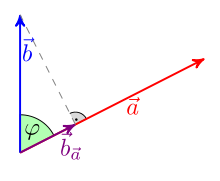Dot product
![]()
This article deals with the multiplication of two vectors whose result is a scalar. For the multiplication of vectors with scalars whose result is a vector, see scalar multiplication.
The scalar product (also inner product or dot product) is a mathematical connection that assigns a number (scalar) to two vectors. It is the subject of analytical geometry and linear algebra. Historically, it was first introduced in Euclidean space. Geometrically, one calculates the scalar product of two vectors 

Here 


In a Cartesian coordinate system, the scalar product of two vectors 

Knowing the Cartesian coordinates of the vectors, one can use this formula to calculate the scalar product and then the formula from the previous paragraph to calculate the angle φ 

In linear algebra, this concept is generalised. There, a scalar product is a function that assigns a scalar to two elements of a real or complex vector space, more precisely a (positive definite) Hermitian sesquilinear form, or more specifically, in the case of real vector spaces, a (positive definite) symmetric bilinear form. In general, a scalar product is not defined a priori in a vector space. A space together with a scalar product is called an inner product space or prehilver space. These vector spaces generalise Euclidean space and thus enable the application of geometric methods to abstract structures.
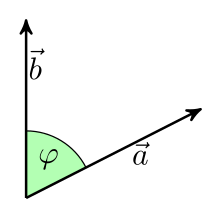
The scalar product of two vectors in Euclidean visual space depends on the length of the vectors and the included angle.
In Euclidean space
Geometric definition and notation
Vectors in three-dimensional Euclidean space or in the two-dimensional Euclidean plane can be represented as arrows. Arrows that are parallel, of the same length and oriented in the same way represent the same vector. The scalar product 


Let 






As with normal multiplication (but less often than there), if it is clear what is meant, the multiplication sign is sometimes omitted:
Instead of one occasionally writes
Other common notations are 
Illustration
To visualise the definition, consider the orthogonal projection 


Then 


This relationship is sometimes also used to define the scalar product.
Examples
In all three examples 



· 


· 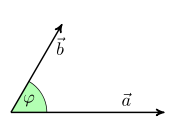


· 


In Cartesian coordinates
If one introduces Cartesian coordinates in the Euclidean plane or in Euclidean space, each vector has a coordinate representation as a 2- or 3-tuple, which is usually written as a column.
In the Euclidean plane one then obtains for the scalar product of the vectors
and
the representation
For the canonical unit vectors 


From this follows (anticipating the properties of the scalar product explained below):
In three-dimensional Euclidean space, one obtains accordingly for the vectors
and
the representation
For example, the scalar product of the two vectors is calculated as follows
and
as follows:
Properties
From the geometric definition it follows directly:
- If
and are
parallel and equally oriented (
), the following holds
- In particular, the scalar product of a vector with itself gives the square of its length:
- If
and are
parallel and oppositely oriented (
), the following applies
- If
and
are orthogonal (
), then
- If
an acute angle, then
- If
an obtuse angle, then
As a function that assigns to

- It is symmetrical (commutative law):


- It is homogeneous in each argument (mixed associative law):



- It is additive in each argument (distributive law):



Properties 2 and 3 can also be combined: The scalar product is bilinear.
The designation "mixed associative law" for the 2nd property clarifies that here a scalar and two vectors are linked in such a way that the brackets can be interchanged as in the associative law. Since the scalar product is not an inner linkage, a scalar product of three vectors is not defined, so the question of true associativity does not arise. In the expression 



Neither the geometric definition nor the definition in Cartesian coordinates is arbitrary. Both follow from the geometrically motivated requirement that the scalar product of a vector with itself is the square of its length, and the algebraically motivated requirement that the scalar product satisfies properties 1-3 above.
Amount of vectors and included angle
With the help of the scalar product it is possible to calculate the length (the amount) of a vector from the coordinate representation:
For a vector 
The Pythagorean theorem can be recognised here. In three-dimensional space the following applies accordingly
By combining the geometric definition with the coordinate representation, one can calculate the angle enclosed by two vectors from their coordinates. From
follows
The lengths of the two vectors
and
therefore amount to

The cosine of the angle enclosed by the two vectors is calculated to be
Thus
Orthogonality and orthogonal projection
→ Main article: Orthogonality and orthogonal projection
Two vectors 

The orthogonal projection of 


so
The projection is the vector whose endpoint is the plumb line from the endpoint of 


If 

Reference to the cross product
Another way to multiplicatively link two vectors 




The following calculation rules apply to the connection of the cross product and the scalar product:
The combination of cross product and scalar product of the first two rules is also called spar product; it gives the oriented volume of the parallelepiped 
Applications
In geometry
The scalar product makes it possible to prove complicated theorems involving angles in a simple way.
Assertion: (cosine theorem)
Proof: Using the vectors drawn in, it follows 

and thus
In physics
In physics, many quantities, such as the work 
with the vectorial quantities force 




Example: A wagon of weight 



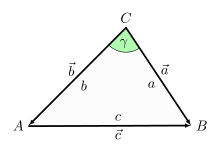
Cosine theorem with vectors
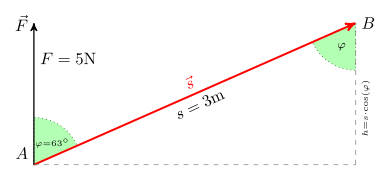
Example inclined plane
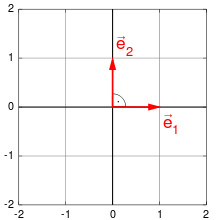
Canonical unit vectors in the Euclidean plane
See also
- Quaternion
- Semi-inner product
- Dual pairing
Questions and Answers
Q: What is the dot product in mathematics?
A: The dot product is an operation that takes two vectors as input and returns a scalar number as output.
Q: What does the dot product depend on?
A: The dot product depends on the length of both vectors and on the angle between them.
Q: Why is the name of the dot product derived from the centered dot "·"?
A: The name is derived from the centered dot "·" that is often used to designate this operation.
Q: What is the alternative name for the dot product?
A: The alternative name is scalar product, which emphasizes the scalar (rather than vector) nature of the result.
Q: What is the contrast between the dot product and the cross product in three-dimensional space?
A: The dot product produces a scalar number as result, while the cross product produces a vector as result.
Q: What is the dot product used for in mathematics?
A: The dot product can be used to determine if two vectors are perpendicular (have an angle of 90 degrees), and to project one vector onto another.
Q: Can the dot product be used in higher-dimensional spaces?
A: Yes, the dot product can be extended to higher-dimensional spaces by generalizing the definition.
Search within the encyclopedia





















































